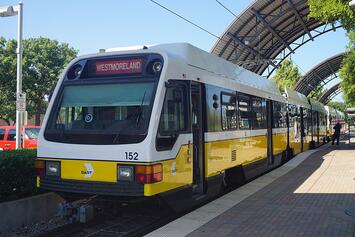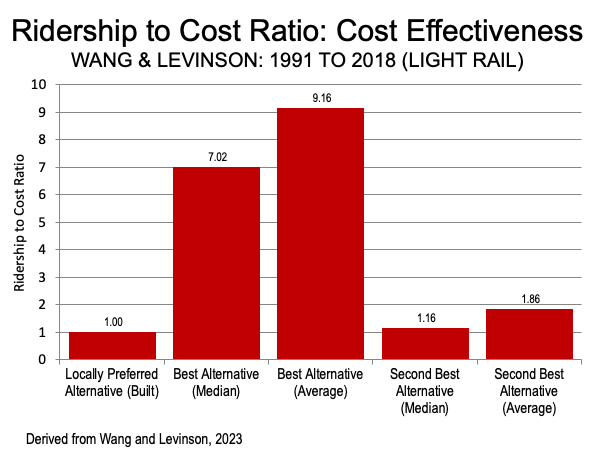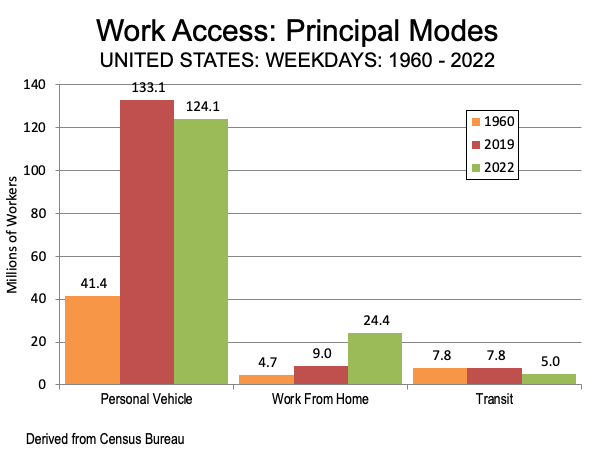
New research by Yadi Wang and David Levinson at the University of Sydney (Australia) casts considerable doubt on the outcomes of major transit projects in the United States (“The overlooked transport project planning process—What happens before selecting the Locally Preferred Alternative?”). Levinson had previously been at the University of Minnesota, where he was involved in ground breaking research on access to jobs in US metropolitan areas and has published similar research at the University of Sydney (with Hao Wu).
The Suboptimal Local Preferred Alternative (LPA)
Wang and Levinson declare “the primary objective of this paper is to prepare a complete ‘alternative history’ ex post evaluation and investigate the process of judging the robustness and viability of the selected option considering the competing alternatives that were ultimately discarded.” The research covers 43 light rail projects in the United States that opened between 1991 and 2018. They compare the cost and ridership projections for selected alternatives (locally preferred alternative or LPA), comparing these to the costs and ridership projections of the rejected alternatives.
The results suggest, remarkably, that lower cost projects were virtually always “renounced.” The authors also cite a number of studies suggesting that “selection bias” toward a particular mode can be a factor in less optimal alternatives being adopted. They use a “ridership to cost ratio” (RCR), which “contrasts the unit cost at which the proposed transit alternative can serve one additional transit patron,” as the primary measure of assessing the relative advantage of alternatives. The results are stunning, with the principal rejected alternative (such as projects relying on bus rapid transit or other modes) having an RCR of 9.16 relative to the LPA (916% more cost effective in terms of ridership) and a median RCR of 7.02. (Figure 1)

Advancing the State of Research from Pickrell and Flyvbjerg
These findings are parallel to those of previous researchers who identified substantial cost increases compared to projected costs and the failure of new projects to attract the forecast demand, such as the Federal Transit Administration research of Donald Pickrell (A Desire Named Streetcar Fantasy and Fact in Rail Transit Planning) and the international infrastructure research by Oxford’s Bengt Flyvbjerg et al (Underestimating Costs in Public Works Projects: Error or Lie?). More recently the Marron Institute at New York University has documented the higher costs of developing urban rail systems in the United States in international comparisons.
Vindicating the Light Rail Critics
In many communities, local interests were well aware of the fact that transit planning was “going off the rails” with its light rail selection bias. Many of the rail critics have been vindicated by this research, including citizen organizations that sought to have more costly alternatives rejected in Honolulu, Houston, Seattle, Phoenix, Dallas, Austin, Minneapolis-St. Paul, Orlando, Denver, Charlotte, Baltimore, San Jose, Salt Lake City, Virginia Beach-Norfolk and elsewhere.
The Cost is the Benefit?
Wang and Levinson cite systemic problems with the US planning process in which public agencies seeking to build major transit capital projects “prefer capital-intensive projects to modest-cost projects because "financial risks are jointly or even mostly shared by higher-level authorities and ultimately transferred to taxpayers.” In other words, “the cost is the benefit” (a familiar saying in transit, but not known who said it first).
Six Decades of Decline
For decades, US public policy has favored transit, seeking to attract drivers from their cars in order to reduce traffic congestion and air pollution. In fact, transit has been unsuccessful at this objective and transit has become increasingly irrelevant in much of the nation, with the exception of New York City, some if its inner suburbs and a few large urban cores, such as Chicago, Philadelphia, San Francisco, Boston and Washington.
Before the pandemic (2019), transit ridership in the United States was 7.8 million, approximately the same as in 1960, when the population was nearly 50% smaller. Commuting by car rose from 41.4 million in 1960 to 133.1 million in 2019, an increase of 91.7 million daily. Working from home rose from 4.7 million in 1960 and passed transit to reach 9.0 million in 2019. By 2022, the remote and hybrid work revolution pushed working at home to 24.4 million, while commuting by personal vehicle fell to 124.1 million. It appears that working from home is the only major mode of employment access that has actually reduced personal vehicle use. Transit use dropped to 5.0 million in 2022, now accounting for only 3.1% of work access (Figure 2).

The authors suggest that the “potential opportunity costs of rejecting more economical courses of action which could have likely managed prospective demand at much lower costs, and thus would have enabled more projects to be built and more people to have been served. “Opportunity cost” is defined as “the loss of potential gain from other alternatives when one alternative is chosen.” With respect to the major projects reviewed in this research, transit has been blind to opportunity costs.
Moreover, the author’s estimates may be substantially lower than would have been the case if they had been able to examine documentation using the actual costs (after the comparatively routine cost overruns) and the actual ridership (after overly optimistic ridership projections).
The Cost of Opportunity Cost Blindness
If there had been no selection bias, and the most cost-effective projects implemented, it is likely that many more passengers would have been served, not least by the fact that there could have been more transit improvements. Captive riders — those without access to cars — might have had better access to jobs and poverty could have been reduced.
Moreover, the failure to choose the optimal alternative can be fairly characterized as waste, which is a legitimate concern of taxpayers. The public purpose is best served where the most cost-effective alternatives are adopted. Moreover, if some of the least effective projects had not been built, tax revenues could have been used for more pressing opportunities, or left in the pockets of taxpayers.
Wendell Cox is principal of Demographia, an international public policy firm located in the St. Louis metropolitan area. He is a founding senior fellow at the Urban Reform Institute, Houston, a Senior Fellow with the Frontier Centre for Public Policy in Winnipeg and a member of the Advisory Board of the Center for Demographics and Policy at Chapman University in Orange, California. He has served as a visiting professor at the Conservatoire National des Arts et Metiers in Paris. His principal interests are economics, poverty alleviation, demographics, urban policy and transport. He is co-author of the annual Demographia International Housing Affordability Survey and author of Demographia World Urban Areas.
Mayor Tom Bradley appointed him to three terms on the Los Angeles County Transportation Commission (1977-1985) and Speaker of the House Newt Gingrich appointed him to the Amtrak Reform Council, to complete the unexpired term of New Jersey Governor Christine Todd Whitman (1999-2002). He is author of War on the Dream: How Anti-Sprawl Policy Threatens the Quality of Life and Toward More Prosperous Cities: A Framing Essay on Urban Areas, Transport, Planning and the Dimensions of Sustainability.
Photo: by Michael Barera, DART light rail train in Dallas via Wikimedia under CC 4.0 License.












